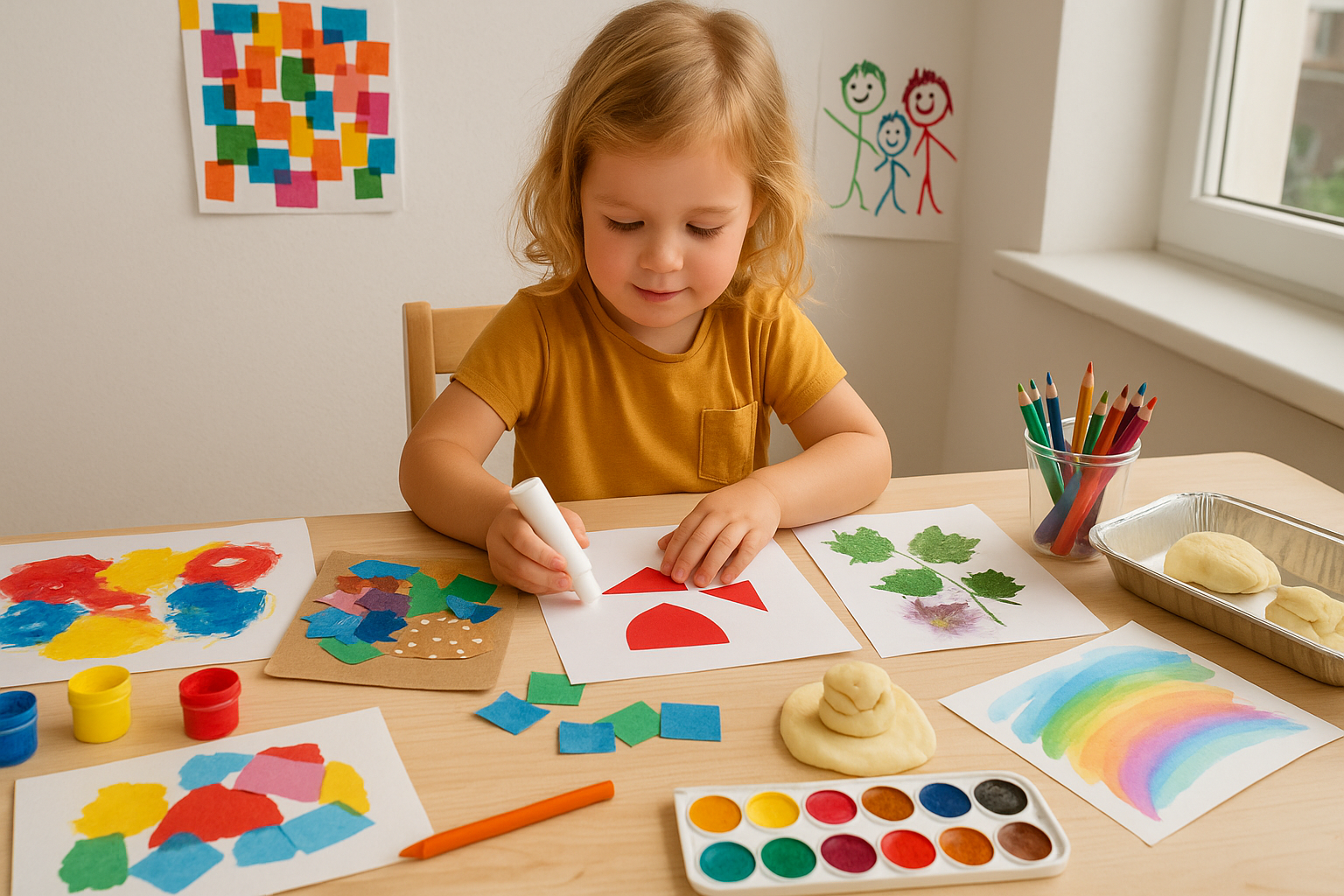Art is more than just a fun activity for preschoolers—it’s an essential part of early development. Through drawing, painting, cutting, and sculpting, children express themselves, build fine motor skills, and learn to think creatively. Best of all, art doesn’t require expensive supplies or complicated instructions. With simple materials and a little encouragement, your child can enjoy meaningful, hands-on artistic exploration at home.
In this article, you’ll discover easy and engaging art projects that foster creativity while supporting early childhood development.
Why Art Matters in Early Childhood
Art supports many areas of development, including:
- Fine motor skills (holding crayons, cutting, gluing)
- Hand-eye coordination
- Self-expression and emotional awareness
- Problem-solving and planning
- Focus and attention span
Art also builds confidence as children see their ideas come to life.
1. Finger Painting with Primary Colors
Finger painting is perfect for sensory play and color exploration.
Materials:
- Washable paint
- Paper
- Apron or old clothes
Activity:
- Let your child freely explore mixing red, blue, and yellow.
- Ask: “What happens when you mix red and blue?”
- Try finger tracing shapes, letters, or just abstract patterns.
Skills: sensory development, color theory, creative expression
2. Collage with Recycled Materials
Teach your child to turn scraps into art.
Materials:
- Old magazines, paper scraps, fabric pieces
- Glue stick or white glue
- Cardboard or thick paper base
Activity:
- Cut or tear pieces and arrange them into a scene, abstract design, or color theme.
- Try making a “feelings collage” using faces or images that show different emotions.
Skills: fine motor control, composition, reuse and recycling awareness
3. Nature Painting
Take art outside by painting with natural tools.
Materials:
- Leaves, flowers, twigs, pinecones
- Paint
- Paper or cardboard
Activity:
- Use the items as brushes or stamps to apply paint.
- Try rolling a pinecone across the paper or printing leaf shapes.
Skills: texture awareness, observation, nature connection
4. Sponge Stamping
Use sponges for fun shapes and patterns.
Materials:
- Sponges (cut into shapes or letters)
- Washable paint
- Tray and paper
Activity:
- Dip sponge shapes into paint and press onto paper.
- Mix colors, create patterns, or build a “sponge city” with shapes.
Variation: Freeze sponge shapes for added sensory interest!
Skills: shape recognition, pattern building, grip strength
5. DIY Salt Dough Sculptures
Make homemade dough for creative 3D art.
Salt Dough Recipe:
- 1 cup flour
- 1/2 cup salt
- 1/2 cup water
Mix and knead until soft.
Activity:
- Sculpt animals, shapes, letters, or food items.
- Let air-dry or bake at low temperature, then paint.
Skills: sculpting, planning, hand strength
6. Watercolor and Crayon Resist Art
Introduce the magic of hidden drawings!
Materials:
- White crayons or candles
- Watercolor paint
- Water and brush
- Paper
Activity:
- Draw shapes, letters, or designs with a white crayon.
- Paint over the paper with watercolors to reveal the drawings.
Skills: curiosity, early literacy, cause and effect
7. Tissue Paper Stained Glass
Create a colorful, light-catching craft.
Materials:
- Clear contact paper or wax paper
- Colored tissue paper
- Scissors
Activity:
- Tear or cut tissue paper into shapes.
- Stick them onto contact paper, then seal with another sheet.
- Hang on a window to see light shine through.
Skills: color exploration, layering, visual design
8. Process Art with Rolling Tools
Focus on the process—not the result—by using rolling tools for texture.
Ideas:
- Roll toy cars through paint
- Use a rolling pin covered with bubble wrap
- Try rolling marbles in a box with paint and paper
Let your child lead the creative process with no final goal in mind.
Skills: experimentation, movement control, open-ended thinking
9. Paper Cutting and Gluing Shapes
Introduce scissors in a safe and creative way.
Materials:
- Colored construction paper
- Child-safe scissors
- Glue stick
Activity:
- Cut shapes to build houses, animals, or patterns
- Sort and glue by size, color, or shape
- Practice cutting along straight and curved lines
Skills: fine motor coordination, shape recognition, concentration
10. Art from Emotions
Let your child turn feelings into artwork.
Prompts:
- “What color is happy?”
- “Can you draw a picture of something that makes you feel brave?”
- “What does ‘excited’ look like on paper?”
Use any medium—paint, crayons, clay—and let the conversation grow around the art.
Skills: emotional intelligence, expressive language, creative storytelling
Tips for a Positive Art Experience
- Don’t focus on the final product. Ask about the process: “What did you enjoy making?”
- Give your child freedom to explore. Avoid correcting or directing their work too much.
- Create an art station with paper, crayons, glue, and safe tools always available.
- Display their work proudly to boost confidence and self-worth.
Let Art Be a Daily Adventure
Art isn’t just an “extra” activity—it’s a vital part of early learning. By including creative time in your daily routine, you’re supporting your child’s growth in countless ways.
Through art, children learn to express who they are, explore the world around them, and take joy in the act of creation itself.
